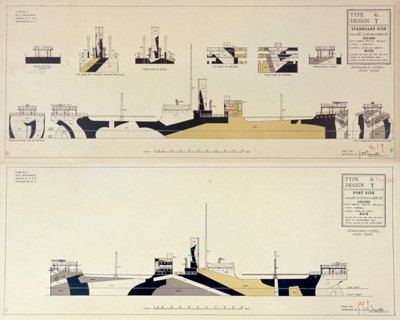|
|
|
| Ship Camouflage Design, Type 6, Design T, Starboard and Port |
Bureau of Construction and Repair
|
|
Acquisition Number: 2007-025-15 2007-025-16
Medium: Lithograph
Status:
Locating enemy ships at sea before the development of radar depended on visual sightings, sound-ranging artillery shots, or radio signal direction finding. Ultimately, the latter two also depended on sightings to confirm their accuracy, so navies of this era began experimenting with camouflage designs intended to misdirect observers. The U.S. Navy Bureau of Construction and Repair began testing ship camouflage, colloquially referred to as “dazzle paint,” during World War I. The technique relied on reducing the contrast of the ship from its surroundings when viewed from the surface or the air and the contrast of one section of a ship from another. The effect was intended to cause observers to misjudge the course, speed, and size of the camouflaged ship. Designs included a moderate range of colors (hues), though post-war experiments would demonstrate that brightness contrasts were more important than color varieties.
Courtesy of Navy Art Collection, Naval History and Heritage Command
|
|
